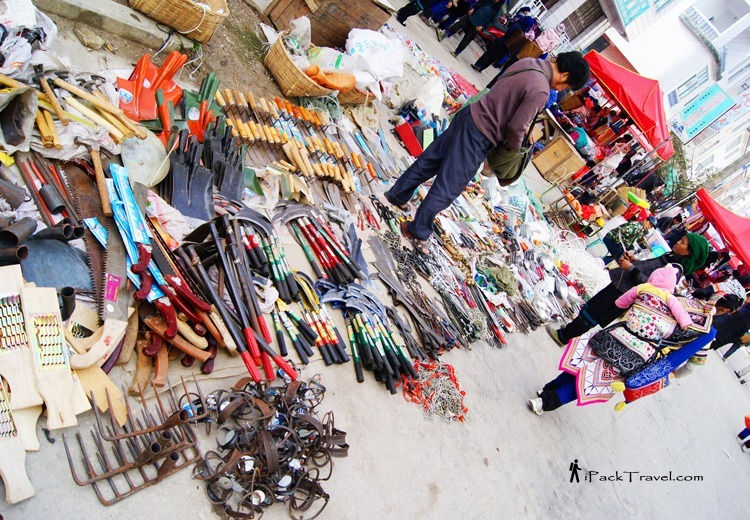China #10: Market Day in Yuanyang Sheng Village (元阳胜村赶集日)
- Rick

- Jan 7, 2018
- 4 min read
Updated: Jul 17, 2023

Sights: A Market Day in Yuanyang Sheng Village (元阳胜村赶集日)
Region: Yuanyang Country, Honghe Hani & Yi Autonomous Prefecture, Yunnan Province
注:云南省.红河哈尼族彝族自治州.元阳县
Previous story:
This story is the second part of a two-part story on Yuanyang Hani Terraced Field (元阳哈尼梯田) in Yunnan. Do check the previous story on the scenic areas in Yuanyang and important information for planning a full day itinerary to check out the various sights. This post continues from part one and visits the life of the ethnic minorities on a market day in Sheng Village (胜村).
Let's have a glimpse of Pugao Old Village (Pugao Laozhai, 普高老寨), where I stayed when I was in Yuanyang Rice Terraces, before going to Sheng Village (胜村) for its market day.
Pugao Old Village (普高老寨)
Pugao Old Village is located in Duoyishu Scenic Area (多依树景区). I explored the old village on a misty day. Most of the houses had been upgraded with yellow bricks but still preserving a rustic feel.


A common sight in the village were yellow corns hanging out to dry outside the walls. These corns were for feeding buffaloes, goats, etc, that the villagers reared or for sales.

The paths in the village were for both people and buffaloes. Amazingly, these two buffaloes knew their way around the village without anyone to lead them.

Sheng Village (胜村)
Sheng Village was located along the main road between Duoyishu Scenic Area and Bada Scenic Area (坝达景区) — it could not be missed. The best time to be in the village was when the ethnic minorities people were having their market days, which was said to take place once every 5 days from 10am to 2pm. Jojo and me were lucky to be in Yuanyang when they had their market day.
Walking in Sheng Village, it would not be difficult to note that the buildings here were more modern in architectures than Pugao Old Village. It was a commercial centre after all.

One of the houses had thousands of dried corns hanging above its front pouch. These were for selling in the markets. By the way, Xingjie Town (新街镇) also had its own market days but not on the same day as Sheng Village.

We asked these Yi (彝族) ladies, who were knitting by the roadside, if we could take a photo.

In the marketplace, these Hani (哈尼族) ladies were shopping with woven baskets. Some were made by themselves while others were bought from the marketplace. Noticed that bright-blue colour seemed to be very popular among the ladies.

Two ladies checking out the meat.

This was the centre where grains and dried goods, such as dried corns, were sold. Since grains were the main staple to both the people and animals, this place was the most crowded.

All kinds of fruits were sold in the fruit section. While majority of the minority people in Sheng Village were Hani and Yi people, there could be some from other tribes too.

Look at the long row of bananas.

It's probably time to replace worn-out tools.

These were smoking pipes, made from bamboo stems, of the ethnic minorities with various types and grades of smoking grasses. The minorities' smoking pipe is also one of Yunnan's 18 Oddities, "竹筒当烟袋" (meaning bamboo stem is used as smoke pipe). #Yunnan18Weird

An elderly Yi lady with her newly-bought piglets.

Minority ladies like silver accessories. These accessories were made with silvery coins from all over the world.

Grilled food were the most commonly seen along the street. One of their specialty was grilled rice dumpling (烤粽子). We did not hesitate to snack on some too.


These were fermented wines from various types of grains, and probably for different purposes. The alcohol contents were very high and usually used for cooking. I bought a small bottle to prepare for the coming cold winter, but they were too much stronger than sweet rice wine (甜米酒).

One of the locally produced grains in Yuanyang rice terraces was the red rice. The minority people would also use red rice to make sweet rice wine after fermentation. The red rice residue (甜酒酿) was eaten as dessert instead of being wasted. They were sweet, of course.

The prices of most items in Sheng Village were very cheap as they were for the locals, not tourists. For travellers, it would be a good place to understand their cultures, enjoy the food and perhaps buy a costume of the minority people as souvenirs or dressed as fusion-fashion for ladies.
After checking out Sheng Village and Yuanyang Hani Terraced Fields, it was time to leave the wonderful place. We went back to Kunming (see Story #8) for a night before setting off for Dongchuan Red Land the following day. Check out that beautiful place too.
Next stop in Kunming:



Comments